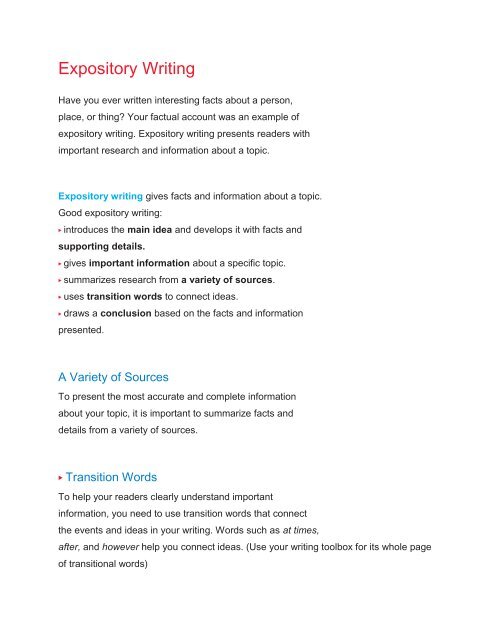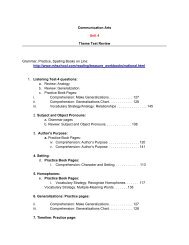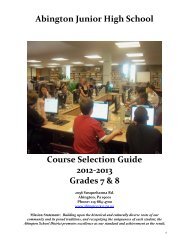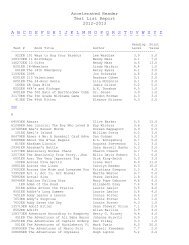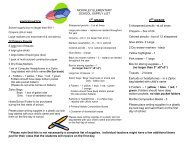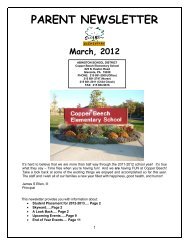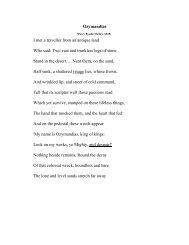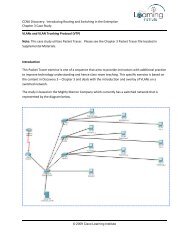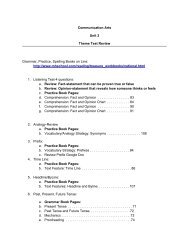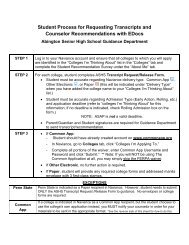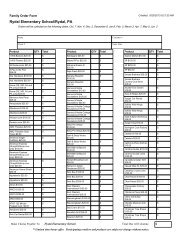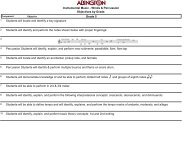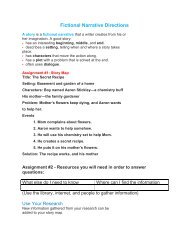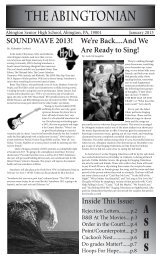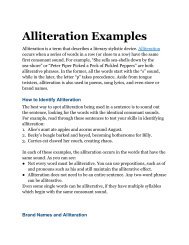Expository Writing
Expository Writing
Expository Writing
You also want an ePaper? Increase the reach of your titles
YUMPU automatically turns print PDFs into web optimized ePapers that Google loves.
<strong>Expository</strong> <strong>Writing</strong>Have you ever written interesting facts about a person,place, or thing? Your factual account was an example ofexpository writing. <strong>Expository</strong> writing presents readers withimportant research and information about a topic.<strong>Expository</strong> writing gives facts and information about a topic.Good expository writing:▶ introduces the main idea and develops it with facts andsupporting details.▶ gives important information about a specific topic.▶ summarizes research from a variety of sources.▶ uses transition words to connect ideas.▶ draws a conclusion based on the facts and informationpresented.A Variety of SourcesTo present the most accurate and complete informationabout your topic, it is important to summarize facts anddetails from a variety of sources.▶ Transition WordsTo help your readers clearly understand importantinformation, you need to use transition words that connectthe events and ideas in your writing. Words such as at times,after, and however help you connect ideas. (Use your writing toolbox for its whole pageof transitional words)
▶ A Conclusion To help your readers know the paper has reached its end, orconclusion, see your <strong>Writing</strong> Toolbox for a page of terms that signify you are about toend your paper. You may: 1) summarize your paper, 2) write about one additional factyou found interesting, 3) ask some questions you would like to have answered in afuture paper about your subject, and/or 4) give a personal response to what you havelearned, if you thought it was interesting you must explain ‘why’, and if you did not likelearning about your subject, you must likewise explain ‘why’.PrewriteThe purpose of expository writing is to give yourreaders informationChoose a TopicStart by brainstorming a list of topics.Organize • OutliningThe facts and details in expository writing are organizedaround an introduction, a body, and a conclusionExample:The First ThanksgivingI. IntroductionA. Pilgrims had the first Thanksgiving.II. Moving to New EnglandA. Pilgrims traveled from England to New England.1. Settled Plymouth ColonyB. They wanted a better life.III. Life in New EnglandA. Pilgrims had a hard time living in New England.1. Not enough foodB. Native Americans helped the PilgrimsIV. ConclusionA. Pilgrims had a feast to celebrate their harvest.B. They shared the feast with Native Americans
▶ Writer’s ResourcesTo get more information for your report, you will haveto do research. First, write questions to guide you. Thendecide which resources you will need to answer them.▶ Use a Time LineYou can discover when an event took place by lookingat a time line. A time line is a diagram that shows when aseries of events took place. Time lines help you keep trackof the order of events.DraftOUTLINEBefore you begin writing your report, review the outlineyou have made. Plan to make a paragraph for each idea■ Remember your purpose and audience.■ Give important information about a specific topic.■ Be sure that your facts and details in each paragraph support the main idea.■ Write a strong introduction, body, and conclusion.■ Draw a conclusion based on the facts and details you presented.ReviseElaborateOne way to improve your writing is to elaborate.When you elaborate, you add important ideas, facts, anddetails that might be missing from your writing. When yourevise your expository writing, you may need to tell moreinformation about key events.
The information that this writer added lets the readerknow when an event happened.Better ParagraphsAs you revise your draft, check your paragraphs tomake sure they fit together well. Read the paragraphs aloud.Do the details in each paragraph support the main idea?Does the information flow from one paragraph to the next?Rearranging paragraphs or changing parts of a paragraphmay improve the overall flow of your report.Proofread/EditAfter you have revised your expository writing, youwill need to proofread and edit it to find and correct anymistakes in mechanics, grammar and usage, and spelling.Review the Rules:GRAMMAR• An adjective is a word that describes a noun or a pronounand tells what kind, which one, or how many. You can usean adjective to combine two sentences that tell about thesame noun or pronoun. When you combine two sentences,leave out words that repeat.• A pronoun takes the place of one or more nouns.Pronouns can be singular or plural and can be used aseither subjects or objects in a sentence.MECHANICS• An abbreviation is a shortened form of a word. Mostabbreviations begin with a capital letter and end with a period.
Self Check-<strong>Expository</strong> <strong>Writing</strong>❑ Who was my audience? Did I give them enough informationabout my topic?❑ What was my main topic? Did I include enough facts anddetails to support it?❑ Did I begin in a clear and interesting way? Did I summarizemy ideas at the end?❑ Did I present my information in the best order? Did I use theright transition words to connect my ideas?❑ Did I combine sentences? Do my sentences flow together?❑ Are my paragraphs fully developed with important information?Do I have a clear introduction, body, and conclusion?❑ Did I proofread and correct all errors?Research Report
Score Description4Excellent - 4■ uses reliable sources and has interesting, unusual facts■ is well structured and has a strong introduction and conclusion■ shows awareness of readers and a sense of purpose throughout■ uses transition words and a vivid vocabulary■ uses sentences that flow smoothly and hold the reader’s interest■ is free or almost free of errors3Good - 3■ uses reliable sources and has a main idea and supporting details■ has a logical flow of facts and details■ shows a good awareness of readers and a sense of purpose■ uses relevant language and transition words■ uses a variety of simple and complex sentences■ has minor errors that do not confuse the reader2Fair - 2■ presents a report with some facts based on limited research■ has sections that are hard to follow■ does not show awareness of readers and shows littleunderstanding of topic■ chooses weak words for topic with few transition words■ uses awkward phrasing and choppy sentences■ makes frequent errors that confuse the reader1Unsatisfactory - 1■ presents a report that is not researched with either no orinaccurate facts■ is structured poorly and is impossible to follow■ does not address readers and shows little or no understandingof topic■ relies on basic vocabulary with no transition words■ includes incomplete and run-on sentences■ makes serious and repeated errors
An example of a – 4 – paper:How Thanksgiving Came to Beby Jamal TraversMany experts believe that the first Thanksgivingtook place in the Plymouth Colony in 1621.In the video Journey to Freedom, Robert Nangexplains how the Pilgrims made the long, hardjourney to New England in 1620. Mr. Nang shows thatthe Pilgrims worked hard in the Plymouth Colony topractice their religion and make a new life.Unfortunately, with little food or help, manyPilgrims died that first winter. In March of 1621,help arrived. A Native American man named Squantotaught the Pilgrims how to fish and plant corn andother new crops. In fact, with Squanto’s help, the fallbrought a great harvest.The Pilgrims were thankful for the harvest, andthey held a three-day feast. They invited Squanto andsome of his friends to help them celebrate. That feastwas probably the first Thanksgiving.


